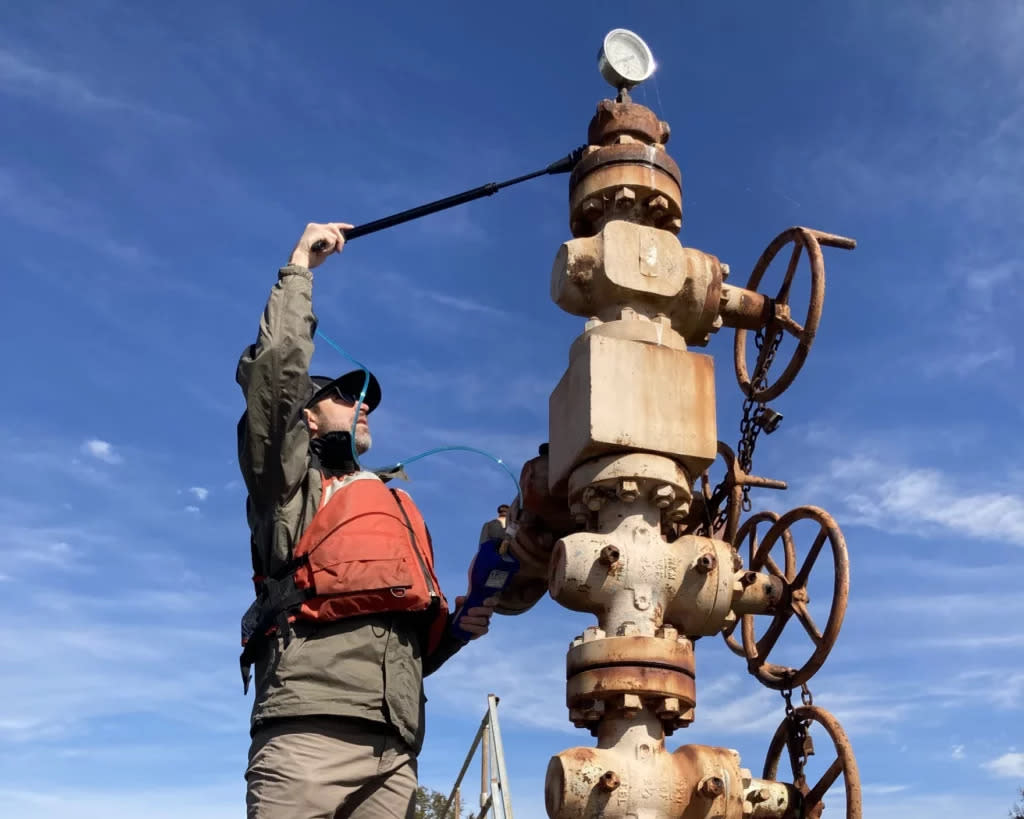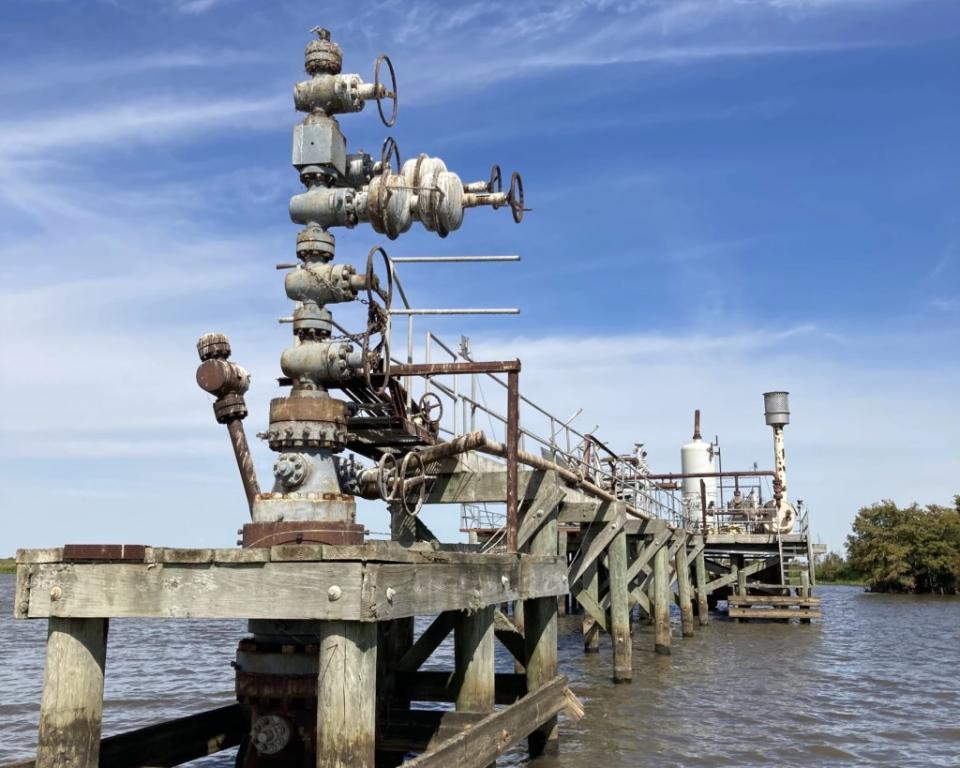Leaky landscape: Old oil wells could threaten carbon injection safety

A U.S. Fish and Wildlife Service worker tests an abandoned well in Lacassine National Wildlife Refuge near Lake Charles. (USFWS photo)
Oil and gas companies spent more than a century pumping carbon out of Louisiana, leaving a landscape pockmarked with thousands of abandoned wells. Now there are ambitious plans to do the opposite: inject vast quantities of carbon back into the ground in an effort to curb climate change.
But many of the new wells will sit near the old ones, raising concerns that harmful levels of carbon dioxide (CO2) and tainted well water may escape from the increasingly porous ground. CO2 is a colorless, odorless gas that displaces air and can make breathing difficult. At high concentrations, it can cause suffocation.
“It’s not a question of whether these things are going to leak,” said Abel Russ, an attorney with the Environmental Integrity Project, a watchdog organization based in Washington, D.C. “It’s a question of how much is acceptable and how much is going to be happening.”
Louisiana has the highest number of planned carbon storage wells in the country. About one-third of the nearly 200 wells undergoing permit approval across the country would be located in the state, Verite News found in a review of federal and state well applications.
While carbon capture and sequestration, or CCS, has never been tested at scale and some leakage is unavoidable, risks can be minimized by carefully selecting injection sites and designing and operating wells appropriately, many scientists who study CCS say.
Ensuring that CCS projects are safe is “baked into the approval process,” said Patrick Courreges, a spokesman for the Louisiana Department of Energy and Natural Resources. The federal government recently handed the department authority over CO2 wells in the state, a move that’s expected to trim the permitting process from about two years to 18 months. Louisiana isn’t trading quality for speed, Courreges said.
“If you want a permit, you still have to show us you can do it safely,” he said.
Only two other states – Wyoming and North Dakota – have been granted permit authority over CO2 injection sites, also known as “Class VI” wells. Carbon dioxide wells in all other states must undergo review by the U.S. Environmental Protection Agency.
186,000 ‘straws’
Capturing CO2 emitted from refineries and other heavy industries is a key facet of the Biden administration’s efforts to cut greenhouse gases. Billions of dollars in federal grants and tax breaks have sparked a boom in CCS projects, especially along the Gulf Coast, where a large share of the nation’s oil and gas is extracted and processed.
The region also has a massive CO2 storage capacity. According to research by the University of Texas at Austin, the sponge-like rock formations under the Gulf Coast could hold hundreds of billions of tons of carbon dioxide, “representing the largest national resources for CO2 storage and a resource capable of receiving decades of annual regional emissions, and likely national emissions,” UT Austin geologists said in a 2021 report.
Squeezing these new CO2 wells among Louisiana’s old oil and gas wells may be challenging. The state has at least 186,000 abandoned oil and gas wells. Louisiana classifies about 4,500 of these wells as “orphaned” because their operators have gone bankrupt, can’t be located or are unwilling to maintain their sites. Responsibility for cleaning up these orphan wells falls on taxpayers.
Map: Orphan wells and parishes with CO2 well permit applications
Many wells listed as “plugged” may actually have little or nothing preventing gas from escaping, according to a report commissioned by the EIP.
Louisiana’s history of oil drilling began in 1901, but standards for well plugging didn’t take shape for another five decades. Before the 1950s, many wells were abandoned without seals. When companies did plug wells, they often used wood and scrap metal, or sometimes made do with old rags and mud.
The EIP report found that 13% of Louisiana’s abandoned wells, or about 24,000, were plugged before 1953, the year the oil and gas industry began urging operators to use cement and other sturdy materials when plugging wells.
“Basic information is lacking for a large number of abandoned wells, especially those plugged before the modern cementing standards instituted in 1953, and the locations of a number of abandoned wells are likely unknown,” according to the report, which was produced by environmental scientists Robert Rossi and Dominic DiGiulio in December.
All parishes with pending CO2 well permits have groupings of abandoned and orphaned wells. Across the state, about 121,000 abandoned wells are scattered over ground suitable for CO2 storage, and about 13,000 of these wells were plugged before modern cementing standards, the report said.
Russ, with the EIP, likens the wells to “a bunch of straws poking into the ground.” Many of these “straws” tap into shared spaces or interlinked rock formations. “If those straws are deep enough, that’s a direct pathway for carbon dioxide to push right back into the atmosphere,” he said.
GET THE MORNING HEADLINES DELIVERED TO YOUR INBOX
Escape risks
While storing carbon dioxide underground is a relatively new idea, companies have transported the gas in pipelines for several years. In 2020, a CO2 pipeline used for pressurized oil extraction ruptured in Satartia, Mississippi, causing several people to feel disoriented or pass out. At least 200 Satartia residents were forced to evacuate and 45 people were sent to hospitals. Concerns about the same ExxonMobil-owned pipeline were raised last month when it leaked a large amount of CO2 near Sulphur in southwest Louisiana, triggering road closures and a shelter-in-place advisory.
Storing CO2 underground is largely untested. Leaky wells could cause serious environmental harm and cancel out their climate benefits, said Li Li, an oil and natural gas researcher at Pennsylvania State University.
“If you inject it into the ground and it escapes, not only are your efforts in vain, but the carbon dioxide could also seep into groundwater or aquifers, making the water acidic and potentially causing other environmental issues,” she said.

The EIP report warns about the potential for well wastewater to contaminate underground water supplies. Oil well water, often called brine, is typically saltier than seawater and laced with toxic metals and other chemicals. Injections of water into old wells have caused brine to seep into aquifers in Texas and Ohio. While the impacts of injecting CO2 into wells have received little study, it’s likely the process could also foul groundwater, the report said. Groupings of abandoned wells and proposed CO2 wells overlap with several aquifers in Louisiana, including ones that supply water in Lafayette, Baton Rouge and the North Shore.
A better process?
Courreges, the state energy department spokesman, said Louisiana’s CO2 well approval process is more stringent than the EPA’s and has stronger safeguards for aquifers. In Louisiana, each well must be reviewed and permitted individually rather than as a project composed of multiple wells. No waivers are granted for reducing well depth requirements, and no CO2 sequestration is allowed in the state’s salt caverns.
A sequestration project’s operator must also identify all abandoned wells and other ground penetrations in a proposed storage area. Several key features, including the well’s drill date, depth and plugging material, must also be listed. However, much of this basic information is missing from hundreds of well records. Some wells have no records whatsoever, and their locations are unknown.
Louisiana won’t know the full scope of the potential risks unless it figures out each well’s location and condition. But that’s unlikely. Because there are so many abandoned wells, it would be “exceedingly difficult and time intensive to mount a statewide field campaign” to locate and assess them, the EIP report said. Instead, the state could conduct a “targeted” campaign to assess hotspots where many abandoned wells overlap potential carbon storage areas, the report suggests. Louisiana has no such plans, and will depend mostly on the permit approval process to flag any areas of concern, Courreges said.
Russ, the EIP attorney, said storing CO2 underground to combat climate change could work, but it demands a slower and more meticulous approach.
“It’s not necessarily a bad idea,” he said. “But I think there are a lot of risks and people have been plowing ahead, maybe a little recklessly.”
This article first appeared on Verite News and is republished here under a Creative Commons license.

The post Leaky landscape: Old oil wells could threaten carbon injection safety appeared first on Louisiana Illuminator.

